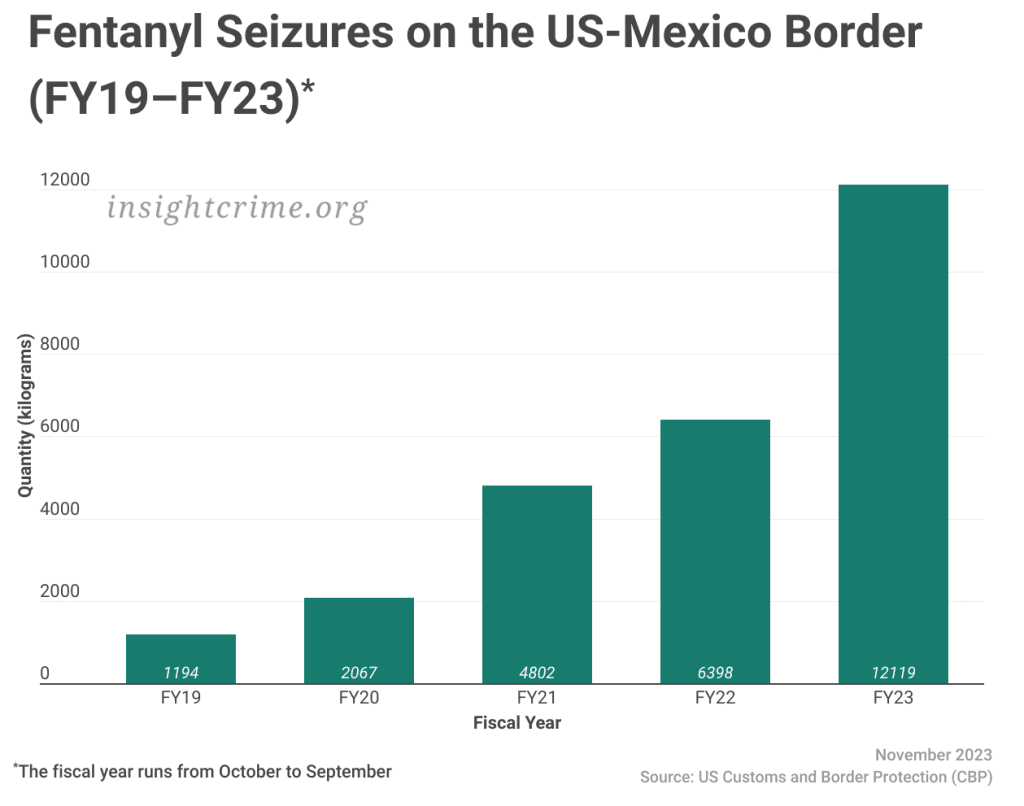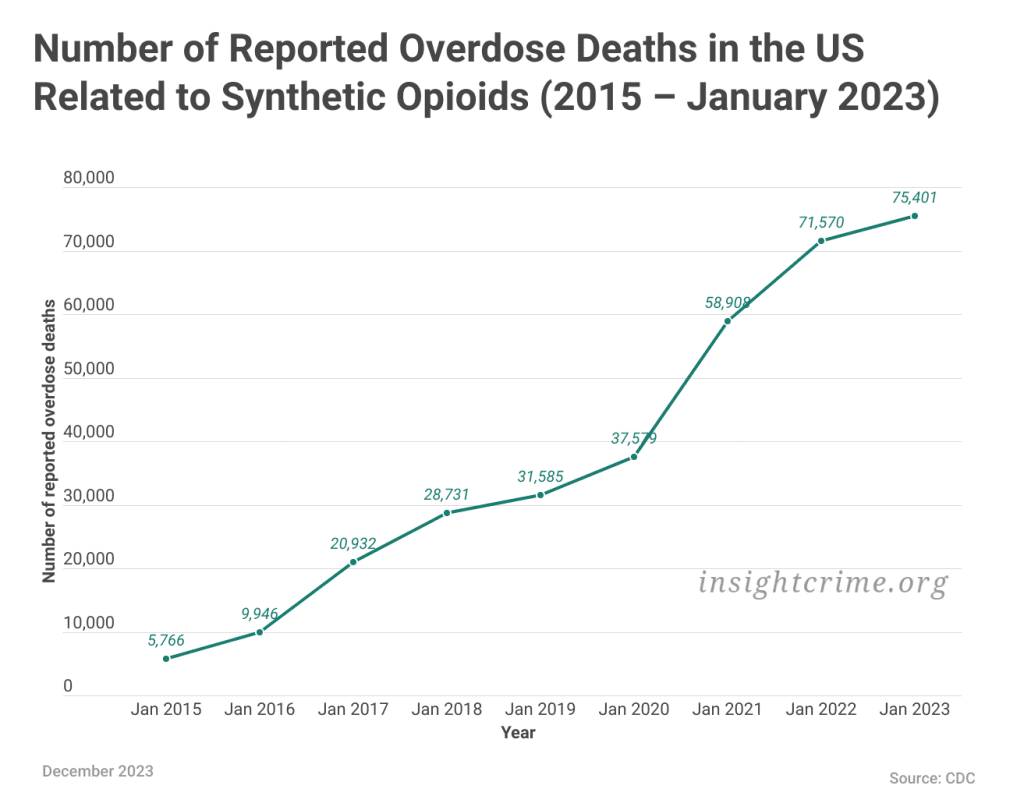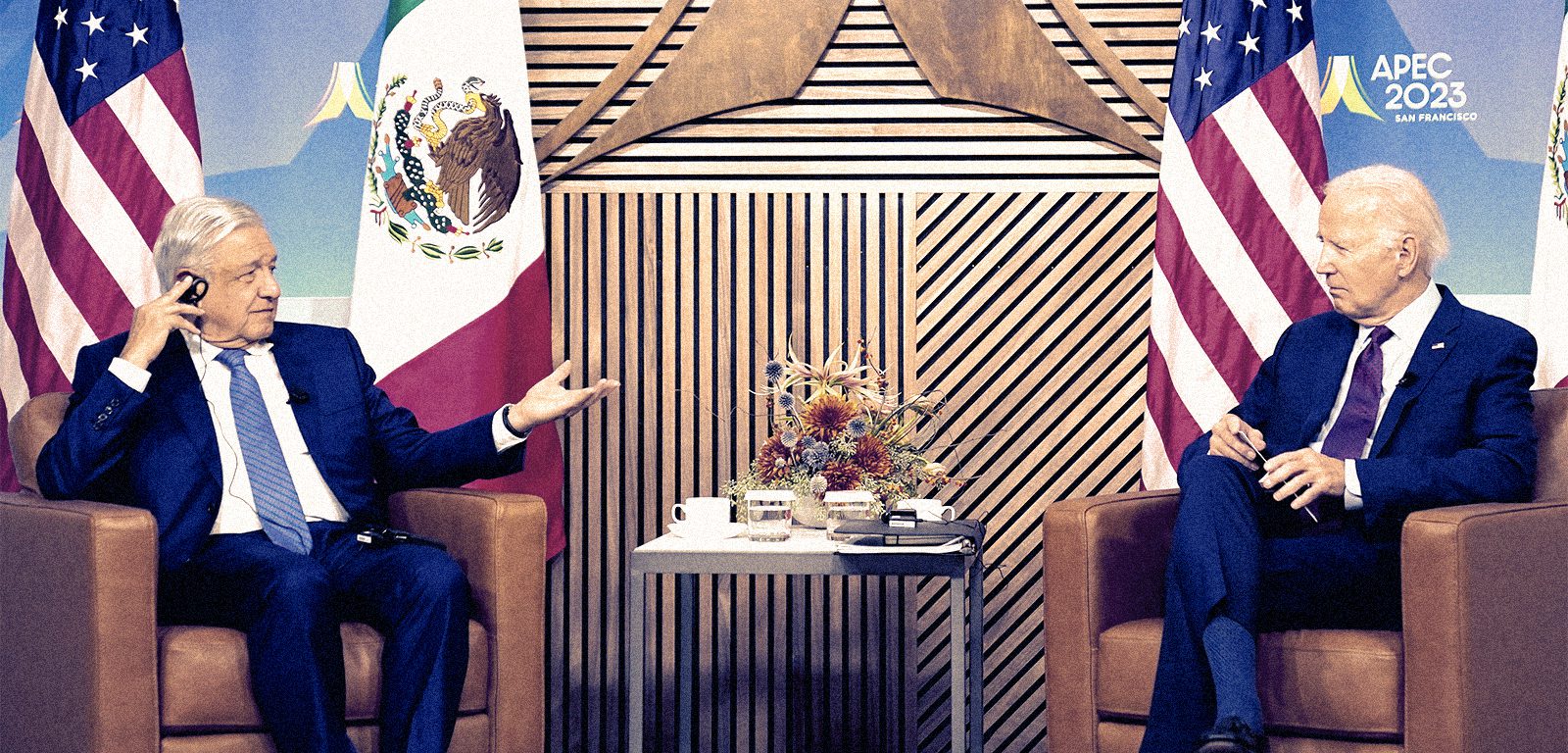The differences in how the United States and Mexico approach the issue of fentanyl trafficking came into stark relief over the past year.
In April 2023, US prosecutors in Washington, DC; Illinois; and New York announced a slew of charges against nearly two dozen suspected Sinaloa Cartel operatives allegedly involved in the group’s fentanyl trafficking operations.
It was the latest example of how the US government had set its sights firmly upon the network’s Chapitos faction, led by Iván Archivaldo Guzmán Salazar, Jesús Alfredo Guzmán Salazar, Ovidio Guzmán López, and Joaquín Guzmán López – all children of Joaquín Guzmán, alias “El Chapo,” the jailed former Sinaloa Cartel leader.
In the eyes of the Americans, the brothers – specifically Ovidio, who had been arrested for the second time months earlier – bore most of the responsibility for the record quantities of fentanyl being smuggled across the US-Mexico border.
“The fentanyl crisis in America – fueled in large part by the Sinaloa Cartel – threatens our public health, our public safety, and our national security,” said Deputy Attorney General Lisa Monaco.


However, for Mexican officials, the situation has not been so black and white. Days after the US Justice Department unsealed the charges against the Chapitos and their associates, Mexican President Andrés Manuel López Obrador accused the US Drug Enforcement Administration (DEA) of “abusive interference” in Mexico, going so far as to say that “no foreign agents should be operating in the country.”
The Mexican president, known widely as AMLO, has long downplayed the severity of the problem posed by fentanyl, as well as Mexico’s role in the crisis. His posture has sparked outrage among US politicians, prompting some to float the idea of granting the US military the authority to combat Mexican fentanyl traffickers themselves.
A History of Cross-Border Tensions
The United States and Mexico have clashed over illicit drugs for more than 50 years, and fentanyl is just the latest manifestation.
In 1969, rising concerns about marijuana use in the United States led then-President Richard Nixon to order a near-total closure of the US-Mexico border with minimal consultation with his Mexican counterparts, which ultimately damaged licit trade more than curbing drug flows.
By the mid-1980s, Mexican organized crime groups were producing marijuana on an industrial scale. And after the 1985 murder of a DEA agent in the city of Guadalajara, then-President Ronald Reagan ordered his own slowdown of border operations in an effort to force the Mexican president to step up efforts to find the missing agent and crack down on drug traffickers.
How Precursor Chemicals Sustain Mexico’s Synthetic Drug Trade
Tensions regarding anti-narcotics cooperation have ebbed and flowed since that time, even with Mexican presidents who otherwise maintained a very close relationship with the United States. In 2011, for example, after the Zetas set a Monterrey casino on fire in an attack that left 52 people dead, then-President Felipe Calderón gave a fiery speech blasting the United States for not taking enough responsibility to reduce the demand for illicit drugs.
Today, many of the disagreements between both countries center on two issues: Mexico’s role in the trafficking of drugs that are killing record numbers of Americans, and the United States’ role in selling weapons that are smuggled into the hands of criminals responsible for an outsized portion of record homicides in Mexico.
The stakes of these tensions are arguably higher than ever before. While both governments struggle to find some common ground, fentanyl has continued flowing across the border at unprecedented levels while drug overdose deaths have increased in both countries, according to data from border officials and health authorities.
As Deaths Climb, Fentanyl Crisis Worsens
In the United States, the fentanyl crisis has become a priority for many politicians due to the vast scale of the drug overdose crisis, which is being driven almost entirely by this synthetic opioid.
The drug is killing more people than ever before. In 2022, data from the Centers for Disease Control and Prevention (CDC) found that opioids, primarily illicit fentanyl, contributed to about three-quarters of around 110,000 overdose deaths recorded across the country. Just seven years earlier, in 2015, US officials saw half as many drug overdose deaths and synthetic opioids were responsible for only a small share.


In recent years, a portion of these deaths have been attributed to counterfeit pills manufactured in Mexico and laced with lethal amounts of illicit fentanyl. However, Mexican authorities have largely viewed the issue as being a problem solely for the United States to handle.
“Here, we do not produce fentanyl nor have fentanyl consumption. We’re really sorry about what is happening in the United States, but why don’t they … combat fentanyl distribution?” Mexican President Andrés Manuel López Obrador charged at a press conference in March.
These differences have strained US-Mexico relations and hamstrung cooperation between the two governments to tackle the powerful criminal networks trafficking the deadly synthetic opioid.
“I would say our cooperation is good. Can it be better? It can always be better, but we’re very pleased to be able to work with our Mexican colleagues,” Todd Robinson, the assistant US secretary of state for international narcotics and law enforcement affairs, said in an interview with the EFE news agency.
While the United States has so far borne the brunt of the crisis, the available data suggests that consumption of fentanyl is also expanding across Mexico. Before long, politicians there may be calling for more action to be taken to confront the problem.
Demand for medical treatment related to fentanyl use, for example, has grown substantially. While just 10 people sought treatment in 2018, that number grew to 333 by 2022, according to data from the Mexican Observatory of Mental Health and Drug Consumption. Moreover, medical centers and civil society groups working on harm reduction and to prevent addiction in border cities, such as Tijuana and Mexicali, are reportedly recording a growing number of lethal fentanyl overdoses.
Even so, President López Obrador has failed to consistently and fully acknowledge the scale of the fentanyl crisis and its impact on both countries. These views have also extended to other parts of his security team.
“Remember that Mexico is not a producer of fentanyl,” Security Minister Rosa Icela Rodríguez Velázquez said during a high-level security dialogue with US officials in October. “Mexico is a country of transit … [and] we have not detected fentanyl production laboratories.”
But not everyone is on the same page. Some officials, such as Foreign Secretary Alicia Bárcena, have been more diplomatic in recognizing the problem and the need for cooperation with the United States.
“Of course, there are illegal [fentanyl] laboratories; that’s what we have found. And of course, we have seized clandestine laboratories, and that’s exactly where we’re collaborating,” she reasoned towards the end of the same bilateral meeting.
A Window of Opportunity?
Although the United States and Mexico were mostly at odds about how to tackle the fentanyl crisis in 2023, not all hope was lost.
To begin the year, the presidents of Canada, Mexico, and the United States convened and formed the Trilateral Fentanyl Committee, a working group that brings together security officials from the three countries to discuss shared challenges and commit to enhanced cooperation.
A few months later, senior leaders from all three governments met to discuss a more comprehensive approach to tackling fentanyl that looked beyond the so-called “kingpin strategy” of arresting or killing organized crime leaders.
But even as they tried to generate new strategies, they continued putting pressure on Mexico’s organized crime groups.


In a potential sign of a much-needed reset on anti-drug cooperation, the January operation to capture Guzmán López was supported and aided by intelligence shared by the United States. The Mexican government then swiftly extradited him to Chicago just eight months later. One former US assistant attorney who prosecuted dozens of drug traffickers said at the time that the “expedited extradition” was undoubtedly “strategic and political.”
This stepped up pressure may be having other impacts as well. Around the middle of the year, the Chapitos reportedly banned all fentanyl production and trafficking in Sinaloa. It remains to be seen how firmly the order is in place and what the potential impacts will be, but it appears bilateral efforts to crack down on fentanyl are rattling some criminal cages.
Indeed, the ban was originally ordered due to increased law enforcement operations against the group, according to InSight Crime interviews with local producers and violence enforcers in the city of Culiacán, the Chapitos’ operational hub in Sinaloa.
What shape joint anti-narcotics work will take in the near future is unclear, but to close out the October security meeting, senior members of the US and Mexican governments stressed their commitment to cooperating with each other.
An Extradition (and a Fentanyl Prohibition) as Mexico Tries a Counterdrug Reset
“When it comes to fentanyl … I have no doubt about Mexico’s commitment to working collaboratively to deal with this huge challenge that we both face because it’s affecting people in Mexico just as it’s affecting so many Americans,” US Secretary of State Antony Blinken said in closing remarks.
Mexico’s Foreign Secretary Bárcena echoed these sentiments and attempted to set the record straight.
“President López Obrador has given his very precise instructions, and that is that we should be supporting and collaborating in everything that has to do with the production, trafficking, consumption of fentanyl. So then, no, there’s no negation, no denial on his part,” she followed.
During a brief meeting between US President Joe Biden and AMLO at the Asia-Pacific Economic Cooperation summit the following month, the two leaders reiterated a shared commitment to halt the trade. During the summit, the Chinese government also announced it would reestablish bilateral anti-drug cooperation with the United States and work to reduce the flow of precursor chemicals used to produce fentanyl.
Time will tell how these words may turn into action. In 2024, presidential elections are scheduled to take place in both Mexico and the United States, and the topic of fentanyl will likely be at the center of the debate surrounding the future of bilateral anti-drug cooperation.

